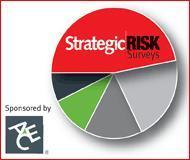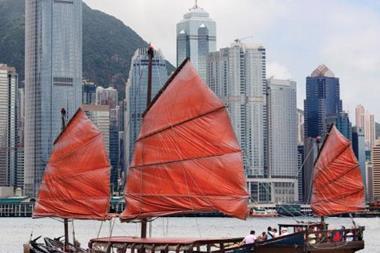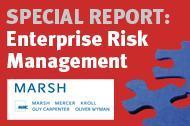As political risk uncertainty rises, the threat landscape is changing. StrategicRISK has teamed up with ACE to find out what tops your list of concerns and what you’re doing to mitigate them
Recent economic upheaval, government intervention and volatile market conditions are redefining political risks and leading to an evolution of the threat landscape. Terrorism, labour activism, protectionism and economic mismanagement are some of the biggest threats facing companies in the year ahead, according to StrategicRISK’s latest reader survey.
In the midst of a recession-fuelled and increasingly lively political risk environment, StrategicRISK ran an online survey of 100 readers, mainly risk managers, to identify key attributes of the new and evolving risks and understand how companies are dealing with them.
The findings confirmed our initial hypothesis that political risk uncertainty was on the rise. An overwhelming majority (96%) of respondents said they believe political risks have increased in the past three years. Terrorism, violence in Pakistan and labour activism all topped the poll as the biggest security concerns over the coming year, and these were augmented by political risks, such as government’s mismanaging the economic recovery, protectionist tariffs and export embargoes.
Lower down the list, but still considered by the respondents to be causing serious concerns in 2010, were the threat of Russia cutting off energy supplies, a heightened threat of bribery and corruption, higher taxes, the prospect of regime change, asset expropriation, and renewed violence between Israel and Lebanon.
Rising unemployment and labour activism were considered to be the principal causes of civil unrest, followed by an increasing demand for food and water, and environmental activism.
Overall, respondents believe that the Middle East and the Asian sub-continent (India, Afghanistan, Pakistan and Bangladesh) are the politically riskiest parts of the world. Africa was seen to be the next riskiest region, though it scored significantly lower than the top two regions. Eastern Europe, Russia and Central Asia were perceived by respondents to be more risky than South America, China, Japan, North America, Western Europe and Central America. Interestingly, South-East Asia (including Australia) was seen to be less politically risky than all of these other regions.
Energy and infrastructure, which normally top corruption risk indexes, were considered to be the industries most at risk of being affected by political risks, immediately followed by the financial services sector, which is likely to be on the receiving end of strict regulation in the wake of the financial crisis.
Despite recognition that political risks have evolved considerably in recent years, most organisations (64%) admitted their investments in preventative measures have remained the same. Only a third of survey respondents indicated that political risk management activities have increased over the past three years. A small minority (3%) said they had decreased.
Worryingly, when asked to rate their organisation’s capability in managing political risk, less than half (39%) think it could be described as good. The majority describe their activities as either average (50%) or below average (5%). Only 11% of the respondents believe they are very good at managing political risks.
Paradoxically, most organisations feel confident (59%) or very confident (15%) that their organisation has taken appropriate measures against the risks already cited. Organisations were almost evenly split over whether political risk considerations had ever caused them to cancel a planned investment: 55% said they had, 45% said they had not.
On the steps to be taken to manage political risks, most indicated that regular risk assessment of key assets and supply chains or distribution networks is the best form of protection. Also described as useful in combating political risks were due diligence of business partners, investing more in intelligence gathering and compliance activities, strengthening integrity programmes, enhancing security management, and buying more insurance (although this was given as a last step).
Overall, the findings confirm that political risk is evolving and many threats are seen to be extremely pressing for organisations. While some are confident in their ability to cope with the risks, a larger majority of companies feel that they probably need to invest more time and energy in mitigating the threats. Better risk assessments, more intelligence gathering and increased due diligence seem to be the areas in which companies are putting their faith in order to deal with the challenges ahead.
EXPERT VIEW
As 2010 begins, we face the following challenges in business and investment planning:
• the timing of the removal of quantitative easing and wider government stimulus packages;
>below-trend growth in the developed world for the foreseeable future;
>strong emerging market recovery but with potential inflationary and overheating risks in some economies, for example China and Vietnam;
>currency volatility;
>uncertainty over availability of bank finance;
>commodity price volatility, driven by uncertainty over the pace of recovery and linked to government stimulus programmes, potential stock overhangs in some commodities, such as copper due to stock piling in China, and the reversal of speculative capital flows should interest rates rise sooner and faster than currently anticipated by market consensus;
>outlying shocks arising from risks, such as those around Pakistan/India and Iran;
>increasing risks around protectionist policies; and
>potential for increased social unrest and political violence.
Despite the breadth and depth of the crisis that first began to unfold in August 2007, capacity in the political risk and credit insurance market remains relatively unchanged in 2010.
Risk appetite has adjusted, however, particularly in relation to non-investmet grade credit risks in developed markets and emerging market credit risks, especially in Central and Eastern Europe, Russia and the former Soviet satellites in Central Asia.
The crisis has accelerated the shift from the developed world to emerging markets. The share of global GDP and world trade accounted for by emerging markets is expected to continue to rise rapidly. While not all EMs are in the same position, the fact is that for the major economies, their balance sheets are in much better shape, by and large, than those of the developed world.
As a result, there is an expectation that significant further productivity gains and growth can be achieved over the coming years.
As the risks of inflationary pressures and social unrest increase through 2010 and into 2011, so the risk of unconventional policy developments increase, for example governments interfering with supply chains for food and agricultural products.
The key for all organisations will be having a clear structure and strategy for managing these risks and for finding appropriate partners for distributing and sharing them.
Stephen Capon, head of country and credit risk management, ACE Global Markets



















No comments yet